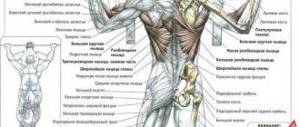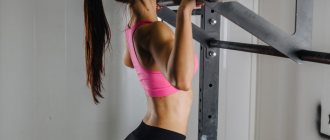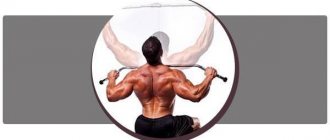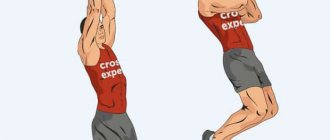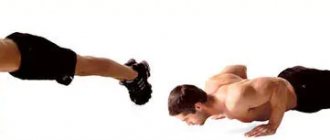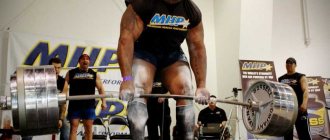Author: Timko Ilya - the ruler of the entire site and fitness trainer | more details >> Rod. 1984 Trained since 1999 Trained since 2007. Author and creator of the site tvoytrener.com. CCM in powerlifting. Champion of Russia and South Russia according to AWPC. Champion of the Krasnodar region according to IPF. 1st category in weightlifting. 2-time winner of the Krasnodar Territory championship in t/a. Author of more than 700 articles on fitness and amateur athletics. Author and co-author of 5 books.
Place in the author rating:
out of competition
(become an author) Date: 2015-04-08 Views: 33,263 Rating: 5.0
| All articles by the author >> | Medals articles >> |
Articles are loading...
In this article we will look at various variations of pull-ups on the bar. Let's look at their features and how they differ from each other in terms of efficiency.
But before that I want to say a few words about pull-ups in general. I believe that pull-ups are basic exercises for the latissimus muscles, biceps and all the muscles of the thoracic back. Without pull-ups, you won’t be able to have a powerful upper body, and you should strive to ensure that you can do at least 15 pull-ups in power mode. That is, without swinging and jerking.
All pull-up options can be divided into 3 types:
- Pull-ups with a straight (classic) grip (palms facing away from you). In this case, you work the lats more and the biceps less.
- Reverse grip pull-ups (palms facing you). In this case, you will work your biceps more and your lats less.
- Parallel grip pull-ups (palms facing each other). Here the biceps and lats work 50/50.
Wide grip pull-ups
These exercises actively form the latissimus, infraspinatus, teres and trapezius muscles . When performing, the torso should be perpendicular to the floor, elbows pointing down, and hands located at a distance greater than shoulder width. You can perform such pull-ups both to the chest and behind the head. In the first case, the latissimus dorsi muscles are included in the work, and in the second, the deltoids. By the way, it was the first version of pull-ups that Arnol Schwarzenegger included in his classic program (see Schwarzenegger’s training program), which indicates its high effectiveness.
Muscle work
Pull-ups with a neutral grip on the horizontal bar help shift the load to the lower region of the latissimus muscles. The hands also work. Thus, the exercise loads the following main groups:
- latissimus dorsi muscle (emphasis on the lower sections);
- biceps (biceps brachii muscle);
- brachial muscle (brachialis).
Yes, girls do this too.
The deltoids, serratus and teres major muscles additionally receive a certain load. As a result, we can conclude that the exercise is used primarily to work out the lower region of the latissimus and is most often used as an auxiliary exercise.
Medium parallel grip pull-ups
These exercises are considered the most traditional version of pull-ups. They give a good load on the brachialis (shoulder muscle), brachiradialis (brachioradialis muscle) and delta . When doing this, your hands should be positioned shoulder-width apart, and your palms should be parallel to each other. When doing a parallel grip pull-up, it is important to touch the bar with your upper chest while squeezing your shoulder blades together. Having reached the bottom point, stretch and straighten your arms. During the exercise, the elbows are constantly parallel to the body.
Recommendations and tips
Here are a number of useful practical recommendations and tips to help you get the most out of the exercise, make it more effective and avoid unpleasant consequences for the body. In many ways, these recommendations overlap with classic pull-ups, but repetition in this case is never superfluous.
- Avoid swinging on the horizontal bar and sudden movements, as this will negate some of your efforts and you will only waste your time. Move smoothly, under control and slowly, so you can achieve maximum results.
- Try to exclude the biceps from the work, concentrate more on tensioning the lats. Make movements with maximum amplitude, focusing on the work of the target muscles.
- Remember that a close grip on parallel bars makes the exercise more of an assistance exercise. If the primary goal of your bar training is to build a powerful back, the first thing you need is good old-fashioned wide-grip pull-ups.
- Try to reach the bar exactly to the level of your chest (upper part), and not with your chin. Then the target muscles (lower part of the latissimus) will receive a more effective load.
- After completing the exercise, do not suddenly jump off the bar (especially from the top point). This will create an unwanted traumatic load on the spine.
- Experienced athletes can use additional weights. Usually these are pancakes or other additional weight, which is attached to a special belt. On average, three sets of 5-8 repetitions with weight will help accelerate muscle growth. In this case, the exercise can be considered basic in the lat training program on the horizontal bar. If we consider it as auxiliary, then it is better not to use weights and focus on the maximum number of repetitions to the limit.
One arm pull-ups
The exercise intensely loads the muscles of one arm . With one hand you need to grab the bar with a reverse grip, and with the other hand you need to grab the forearm of the first hand, although an option is acceptable when the second hand is in a free position.
To achieve the desired result, only the muscles of the back and arms should work. You need to perform the exercise slowly, and at the top point it is advisable to take a short pause, literally one or two seconds, and then slowly lower to the starting position.
Exercise technique
The exercise is performed on a suitable horizontal bar, the starting position is hanging on straight outstretched arms:
- Hang from the horizontal bar by grasping the parallel bars. This grip can be considered quite narrow, since the distance between the bars usually varies and is 30–60 cm (depending on the model of the simulator). Take a deep breath.
- As you exhale, pull yourself up to the top point, try to imagine that you want to touch the bar with your upper chest. In other words, try to maximize the range of motion.
- Having reached the top point, you can stay for a while, taking a short pause, then, inhaling, smoothly, slowly and under control lower yourself to the starting position. Complete the required number of repetitions.
You can use the exercise after an overhand grip pull-up. If your training program includes free-weight bent-over rows (dumbbells or barbells) or lat pull-downs, it is best to perform these exercises after neutral-grip pull-ups.
Do about 3-4 sets of 8-12 reps. The number of repetitions can be unlimited, performing the exercise in each approach, as they say, “to failure.”
Classic pull-up
This exercise is performed with a straight medium grip. With the correct technique, the risk of injury during its execution is reduced to zero. Let's take a closer look at pull-ups with a medium grip and what muscles work during this process.
During execution, the latissimus dorsi, trapezius, and forearms receive the main load; the deltoids and abs are indirectly loaded.
Technique:
- Grab the bar with a straight, medium grip so that your thumb wraps around the bar.
- As you exhale, pull yourself up until your chin is above the level of the bar. At the top, lean back slightly.
- Inhaling, slowly lower yourself down.
- Repeat the movement as many times as necessary.
An overhand grip, or as it is also called a straight grip, is the most common type of grip. All standards are usually met precisely with this position of the hands.
To use an overhand grip, you need to place your hands in front of the bar, palms facing forward, and grab the bar.
You can do pull-ups with narrow, medium and wide grips. The wider the grip, the greater the load on the back muscles; the narrower the grip, the greater the load on the arms.
The hands are placed as close as possible on the horizontal bar, almost touching the thumbs. The thumb is opposite the rest, closing the bar into a ring. When pulling yourself up, you need to bend your back a little and try to reach the bar with your chin.
When doing pull-ups with a narrow overhand grip, the following muscle groups are trained:
- brachialis;
- lower part of the latissimus dorsi;
- serratus anterior muscles.
Hands are positioned shoulder-width apart. The thumb is opposite the rest. Pull-ups are performed without jerking with straight legs. The bars should be touched with your upper chest. At the bottom, fully straighten your arms.
With a medium overhand grip, the main load is received by:
- biceps;
- latissimus dorsi muscles;
- trapezoids.
The muscles of the forearms and shoulder girdle, triceps are also trained.
Hands are positioned wider than shoulders. The thumb is located next to the rest, and does not close the bar into the lock (otherwise it will be simply inconvenient). The pulling movement is performed using the back; the biceps are almost turned off in this exercise. During pull-ups, your forearms should form a right angle with the bar at the top point.
Using a wide grip, you can perform pull-ups to the chest or behind the head.
The main load when doing pull-ups with a wide straight grip falls on:
- the upper and middle (in the case of pull-ups) parts of the latissimus muscles;
- paired teres muscles;
- trapezoid;
- biceps.
What muscles work
When a person, pulling himself up, uses a parallel position of his arms, firstly, the muscles that are called the main ones are worked out:
- latissimus muscles, most of all in the lower part;
- biceps;
- shoulder muscles.
Secondly, during the training process, additional muscles work along with the main ones:
- large round;
- delta muscles;
- toothed;
- The oblique abdominal muscles are slightly pumped up.
Did you know? A Korean man at the age of 70 became the world record holder for pull-ups. This South Korean resident did 612 pull-ups in 1994, spending 2 hours and 40 minutes on it.
Pros and cons of the exercise
By pulling yourself up with a parallel grip, you will achieve the following positive results:
- increase muscle strength in your upper body;
- strengthen your hand grip;
- increase the muscle size of your back;
- stretch your spine, which will prevent pinched nerves (this also promotes back health);
- You will develop pulling movements that are useful for pulling exercises.
However, it should be noted that when placing the arms in parallel, primarily the lower sections of the latissimus muscle swing.
To more actively work the back muscles, you should use a wide grip, and muscle groups are worked out most evenly with a straight (regular) grip. Using a parallel grip is not effective enough for the following muscle groups:
- chest and biceps (parallel does not pump up as well as straight-grip pull-ups);
- lower trapezius (trains worse parallel than reverse grip exercise).
Therefore, for better load when doing pull-ups, the best option would be to change the position of your hands.
The parallel grip option is usually used as an addition to the main types of pull-ups and is often offered at the end of classes. Learn how to increase the number of pull-ups on the horizontal bar and how to properly do pull-ups on the horizontal bar behind your head.
Varieties of exercise
Depending on your grip, you can shift the emphasis of the load to certain muscle groups.
Narrow parallel grip pull-ups
Pull-ups with a narrow parallel grip allow you to focus very well on the work of the large round muscle of the back. To do this, you need to bend a little in the thoracic spine and make the movements a little shorter, without going through the last 15-20 cm of amplitude.
© Andrey Popov — stock.adobe.com
If your gym does not have a special horizontal bar with parallel handles, use a parallel handle from a block exercise machine. Just hang it over the bar and try to reach it with the bottom of your chest while doing pull-ups. The blood flow in the back muscles will be incredible.
Straight-grip pull-ups
Pull-ups with a narrow straight grip are a completely different story. Here a lot depends on your deflection in the thoracic spine. If it is not there, then almost the entire load will be distributed between the forearms, biceps, rear deltoids and trapezius. Such pull-ups are unlikely to make your back even a little bigger or stronger. If you do a slight backbend, close-grip pull-ups turn into an almost isolated exercise for working the lower part of the latissimus dorsi muscles. The main thing is to “catch” the amplitude in which you will constantly feel the work of your back, and not your arms. Wrist straps are very helpful for this. The position of the elbows is also important - they should be pressed to the sides.
Close-grip pull-ups
But pull-ups with a narrow reverse grip shift the load on the biceps. This exercise is very good for its development. In combination with barbell curls and dumbbell hammers, it will lead to good results.
© .shock — stock.adobe.com
Secrets and subtleties of implementation
Professional athletes give the following recommendations for performing pull-ups on the horizontal bar with a parallel grip:
- Do not sway or make too sudden movements - this will reduce the effectiveness of such pull-ups.
- remember a measured pace;
- try not to use your biceps while working (the main tension should go to the latissimus dorsi muscles);
- you need to do the exercise with the greatest amplitude;
- Pull-ups should be performed to chest level for higher performance;
- during exercises on the horizontal bar, you must maintain a vertical plane;
- when moving down, fully straighten your arms;
- follow your breathing: when you inhale, go down, and when you exhale, stretch up;
- at the bottom, linger for a couple of seconds and work out the muscles in the back (sets should be 4-5, 10-15 repetitions).
Did you know? American Michael Eckert, a US Marine sergeant, did the most in one minute in 2015. His record is 50 times.
Pull-ups with a parallel grip are an auxiliary exercise that often ends a set of exercises on the horizontal bar. Such exercises perfectly train your back and form beautiful reliefs on it.
Exercises Pull-ups Sports and fitness Strength training


